Don't wanna be here? Send us removal request.
Text

The Wanderers
The term "Planet" originates from the Greek for wanderer (πλανήτης) Planetes, although the meaning of "wander" wasn't quite as we'd imagine today.
The Greeks of course were referring to the fact that planets in the night sky seemed to wander from their locations against the backdrop of stars in the night sky, as they orbited the Sun. More than that, it took a good while for the Greeks to understand why it was that planets would suddenly stop, reverse a bit before then returning to their normal course of movement (easy when you realise the Sun is the centre of the solar system, and you as an observer are also orbiting, not so easy when you're burnt at the stake for suggesting such things later on in medieval times).

Since then of course and thanks to the amazing work the Ancient Greeks did, we know our planets don't wander, but rather orbit, as does our Sun around the galaxy, and indeed so too the stars.
It's nice to assume that moons orbit planets, and planets orbit stars, and stars orbit galaxies and at the centre of galaxies is a supermassive black hole, all in their place, but evidence is growing to show that this simplistic understanding, and while the observable universe mostly fits this clock-work fashion, the universe is full of rule breakers.

Take for example the first acknowledged interstellar asteroid, Oumuamua that travelled for millions of years across light years to arrive in our solar system just in time for us to be technically savvy enough to spot it and document it. The void between stars is almost certainly littered with such objects, zipping around and whenever they come near to a star system, their heading is slightly altered by the gravity and they are flung off in another direction.
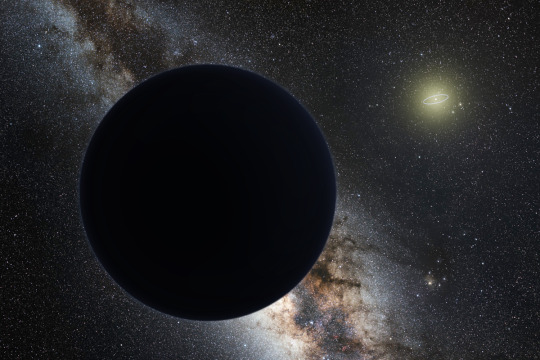
It's not just asteroids that get kicked out of star systems, but entire planets too, true wanderers of our galaxy, moving between the stars having long since been ejected from their home system, most likely by interaction with giant planets like Jupiter, or by chaotic binary orbits. Some even suggest that the planet Uranus is a captured planet, formed outside of our system and at some point captured and settled in the orbit it is today, although there is much evidence to counter such a view, it almost certainly is a possibility that such planets could eventually be captured, such as some moons are captured by their host planets.

Then there was the recent case of a stellar remnant kicked out when it's binary system caused a type 1a supernova, now hurtling through the galaxy on a one way ticket to flying straight out of the galaxy into intergalactic space.
In the same way, stellar black holes are probably flying all over the place, except these beasts are silent when they are not consuming matter, so much so, that some scientists even believe one lies just outside of our solar system and may be causing the odd orbits of the oort clouds, although again, this is hotly disputed.

So if the idea of wandering asteroids, planets, stars and remnant of stars such as white dwarfs or neutron stars and black holes shooting in all directions doesn't give you an inkling of the so called void between the stars, then try a wandering supermassive black hole !
Recent evidence has shown that many galaxies have supermassive black holes where they really shouldn't be, off centre, and sometimes right out at the edges of the galaxy. It seems the further back we look, the more this was occurring, but clearly when galaxies merge, the supermassive black holes don't just fall into each other and merge, they can dance around the galaxy for billions of years before finding a common centre, and even they could remain binary supermassive black holes for further billions of years before finally merging.
The idea that our little Earth has to worry about a few rogue rocks in our solar system is being replaced, space is vast, but it's far from the clock work Newtonian view much favoured by the Victorian scientists who wanted desperately to see God in the heavens, without seeing the devils that lurk out there too.
174 notes
·
View notes
Text
Discovering the Universe Through the Constellation Orion
Do you ever look up at the night sky and get lost in the stars? Maybe while you’re stargazing, you spot some of your favorite constellations. But did you know there’s more to constellations than meets the eye? They’re not just a bunch of imaginary shapes made up of stars — constellations tell us stories about the universe from our perspective on Earth.
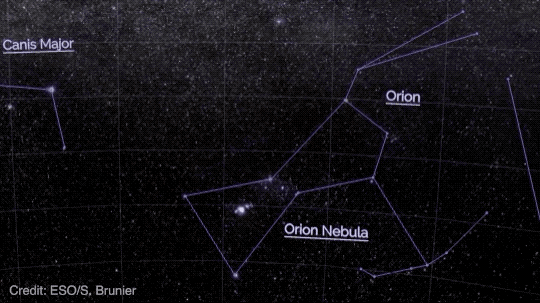
What is a constellation?
A constellation is a named pattern of stars that looks like a particular shape. Think of it like connecting the dots. If you join the dots — stars, in this case — and use your imagination, the picture would look like an object, animal, or person. For example, the ancient Greeks believed an arrangement of stars in the sky looked like a giant hunter with a sword attached to his belt, so they named it after a famous hunter in their mythology, Orion. It’s one of the most recognizable constellations in the night sky and can be seen around the world. The easiest way to find Orion is to go outside on a clear night and look for three bright stars close together in an almost-straight line. These three stars represent Orion's belt. Two brighter stars to the north mark his shoulders, and two more to the south represent his feet.
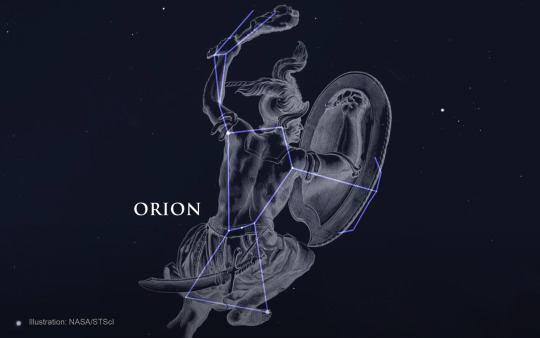
Credit: NASA/STScI
Over time, cultures around the world have had different names and numbers of constellations depending on what people thought they saw. Today, there are 88 officially recognized constellations. Though these constellations are generally based on what we can see with our unaided eyes, scientists have also invented unofficial constellations for objects that can only be seen in gamma rays, the highest-energy form of light.
Perspective is everything
The stars in constellations may look close to each other from our point of view here on Earth, but in space they might be really far apart. For example, Alnitak, the star at the left side of Orion's belt, is about 800 light-years away. Alnilam, the star in the middle of the belt, is about 1,300 light-years away. And Mintaka, the star at the right side of the belt, is about 900 light-years away. Yet they all appear from Earth to have the same brightness. Space is three-dimensional, so if you were looking at the stars that make up the constellation Orion from another part of our galaxy, you might see an entirely different pattern!
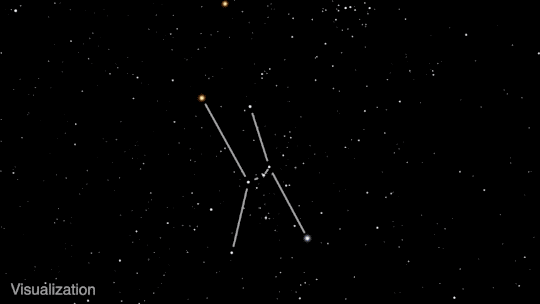
The superstars of Orion
Now that we know a little bit more about constellations, let’s talk about the supercool cosmic objects that form them – stars! Though over a dozen stars make up Orion, two take center stage. The red supergiant Betelgeuse (Orion's right shoulder) and blue supergiant Rigel (Orion's left foot) stand out as the brightest members in the constellation.
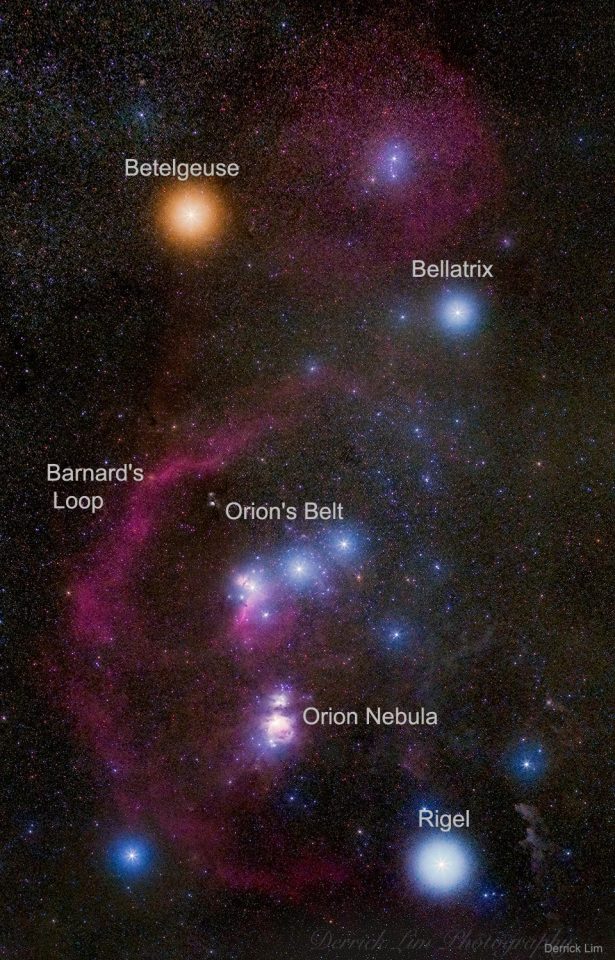
Credit: Derrick Lim
Betelgeuse is a young star by stellar standards, about 10 million years old, compared to our nearly 5 billion-year-old Sun. The star is so huge that if it replaced the Sun at the center of our solar system, it would extend past the main asteroid belt between Mars and Jupiter! But due to its giant mass, it leads a fast and furious life.
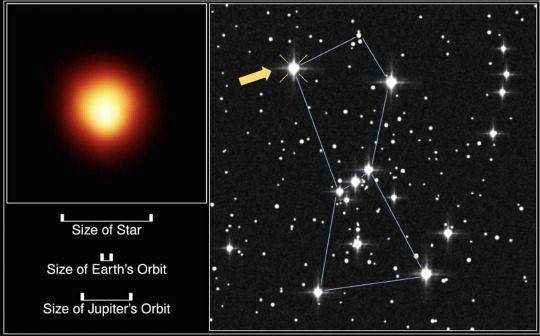
Betelgeuse is destined to end in a supernova blast. Scientists discovered a mysterious dimming of Betelgeuse in late 2019 caused by a traumatic outburst that some believed was a precursor to this cosmic event. Though we don’t know if this incident is directly related to an imminent supernova, there’s a tiny chance it might happen in your lifetime. But don't worry, Betelgeuse is about 550 light-years away, so this event wouldn't be dangerous to us – but it would be a spectacular sight.
Rigel is also a young star, estimated to be 8 million years old. Like Betelgeuse, Rigel is much larger and heavier than our Sun. Its surface is thousands of degrees hotter than Betelgeuse, though, making it shine blue-white rather than red. These colors are even noticeable from Earth. Although Rigel is farther from Earth than Betelgeuse (about 860 light-years away), it is intrinsically brighter than its companion, making it the brightest star in Orion and one of the brightest stars in the night sky.
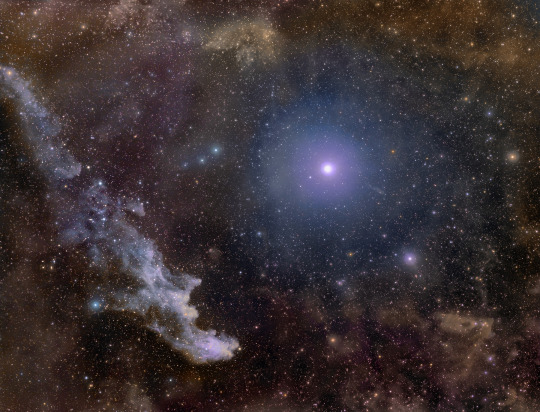
Credit: Rogelio Bernal Andreo
Buckle up for Orion’s belt
Some dots that make up constellations are actually more than one star, but from a great distance they look like a single object. Remember Mintaka, the star at the far right side of Orion's belt? It is not just a single star, but actually five stars in a complex star system.
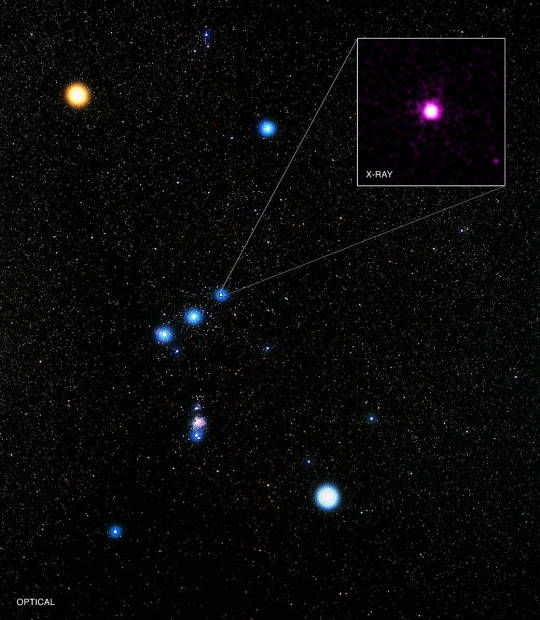
Credit: X-ray: NASA/CXC/GSFC/M. Corcoran et al.; Optical: Eckhard Slawik
Sword or a stellar nursery?
Below the three bright stars of Orion’s belt lies his sword, where you can find the famous Orion Nebula. The nebula is only 1,300 light-years away, making it the closest large star-forming region to Earth. Because of its brightness and prominent location just below Orion’s belt, you can actually spot the Orion Nebula from Earth! But with a pair of binoculars, you can get a much more detailed view of the stellar nursery. It’s best visible in January and looks like a fuzzy “star” in the middle of Orion’s sword.
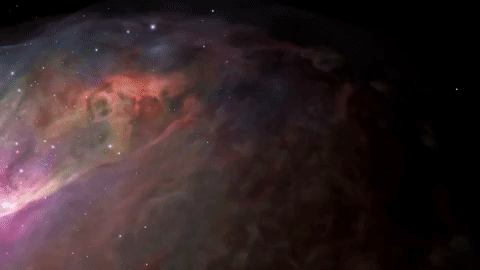
More to discover in constellations
In addition to newborn stars, Orion also has some other awesome cosmic objects hanging around. Scientists have discovered exoplanets, or planets outside of our solar system, orbiting stars there. One of those planets is a giant gas world three times more massive than Jupiter. It’s estimated that on average there is at least one planet for every star in our galaxy. Just think of all the worlds you may be seeing when you look up at the night sky!
It’s also possible that the Orion Nebula might be home to a black hole, making it the closest known black hole to Earth. Though we may never detect it, because no light can escape black holes, making them invisible. However, space telescopes with special instruments can help find black holes. They can observe the behavior of material and stars that are very close to black holes, helping scientists find clues that can lead them closer to discovering some of these most bizarre and fascinating objects in the cosmos.
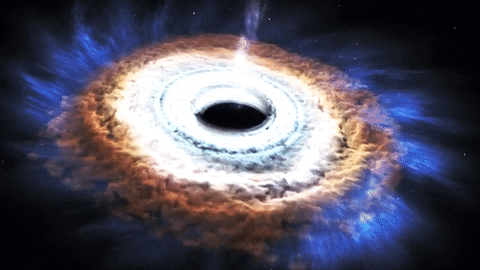
Next time you go stargazing, remember that there’s more to the constellations than meets the eye. Let them guide you to some of the most incredible and mysterious objects of the cosmos — young stars, brilliant nebulae, new worlds, star systems, and even galaxies!
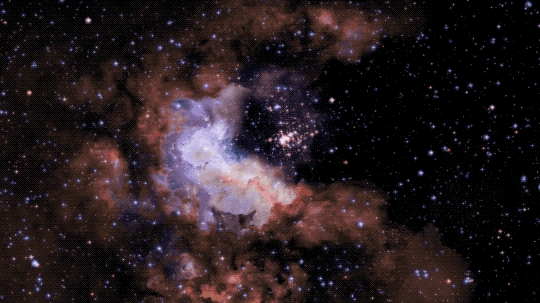
To keep up with the most recent stellar news, follow NASA Universe on Twitter and Facebook.
Make sure to follow us on Tumblr for your regular dose of space!
3K notes
·
View notes
Text
Dr. Beach’s Top 10 Beaches of 2021
For more than 30 years, Dr. Beach, aka Dr. Stephen Leatherman, has created an annual Top 10 Beach list. A professor and coastal geomorphologist at Florida International University, Dr. Beach factors in 50 different criteria including water color, sand softness, wave size, water temperature and more.
As we get ready to launch Landsat 9 this fall, we’re taking a tour of Dr. Beach’s Top 10 US beaches of 2021 as seen by Landsat 8.
10. Coast Guard Beach, Cape Cod, Massachusetts

Coast Guard Beach is located just north of the remote Nauset Inlet on Outer Cape Cod, Massachusetts. Except for the picturesque old white Coast Guard station that still sits atop the glacial bluffs, there is no development here; the best way to reach this beach is by bicycle from the Salt Pond Visitor’s Center or shuttle bus.
First mapped by Champlain in 1605, the shifting sands of this inlet are clearly visible in the Landsat image. This location is also at the point where the glacial sea cliffs transcend into a barrier beach (e.g., sand spit) that provides protection for the lagoon and development of lush salt marshes.
“In my early days as a Professor at Boston University and later at the University of Massachusetts at Amherst, I spent many summer and some winter-time days conducting scientific studies along this barrier beach.” – Dr. Beach
Landsat 8 collected this image of Coast Guard Beach on May 1, 2021.
9. Beachwalker Park, Kiawah Island, South Carolina

Beachwalker Park is a public beach located on the southern part of Kiawah Island, South Carolina. This barrier island in the Charleston area is 10-miles long and features a fine grained, hard-packed beach that can be traversed easily by bicycle.
This Landsat image shows a huge accumulation of sand as a series of shoals on the south end of the island, which can be reached from Beachwalker Park. These sandy shoals will eventually coalesce, becoming an extension of the sand spit that is the south end of Kiawah Island.
“In the early 2000s, I served as the beach consultant to the Town of Kiawah Island because their world-famous golf course on the north end was being threatened by severe erosion. It was necessary to artificially bypass some sand on the north end of the island so that the normal flow of sand along the island was reinstated, saving the outermost link of this PGA golf course.” – Dr. Beach
Landsat 8 collected this image of Beachwalker Park on April 9, 2021.
8. Coronado Beach, San Diego, California

Coronado Beach in San Diego is the toast of Southern California with some of the warmest and safest water on the Pacific coast. This 100-meter-wide beach is an oasis of subtropical vegetation, unique Mediterranean climate, and fine sparkling sand.
The harbor serves as a major port for the Navy’s Pacific fleet, the home port for several aircraft carriers. The docks and the crossing airplane runways for the Naval base are visible in this Landsat image.
“I really enjoy visiting this beautiful beach as well as having lunch and drinks, taking advantage of the hotel’s beachside service.” – Dr. Beach
Landsat 8 collected this image of Coronado Beach on April 23, 2020.
7. Caladesi Island State Park, Dunedin Clearwater, Florida
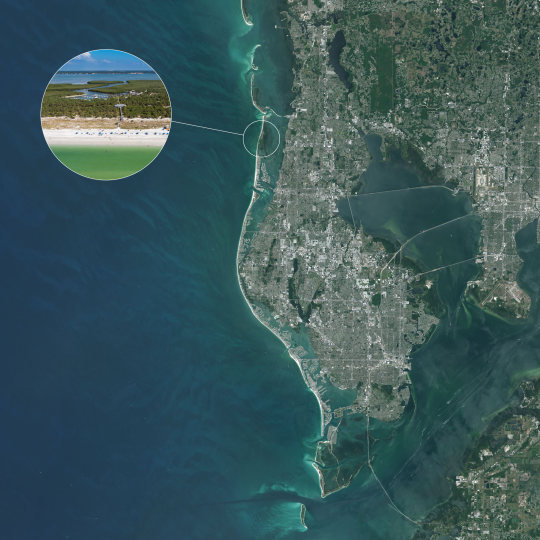
Caladesi Island State Park is located in the small town of Dunedin on the Southwest Florida coast. The stark white undeveloped beach is composed of crystalline quartz sand which is soft and cushy at the water’s edge, inviting one to take a dip in the sparkling clear waters.
While island is still in the Park’s name, Caladesi is no longer a true island as shown on the Landsat image--it is now connected to Clearwater Beach.
“Caladesi is located in the Tampa area, but it seems like a world away on this getaway island.” – Dr. Beach
Landsat 8 collected this image of Caladesi Island State Park on April 9, 2021.
6. Duke Kahanamoku Beach, Oahu, Hawaii
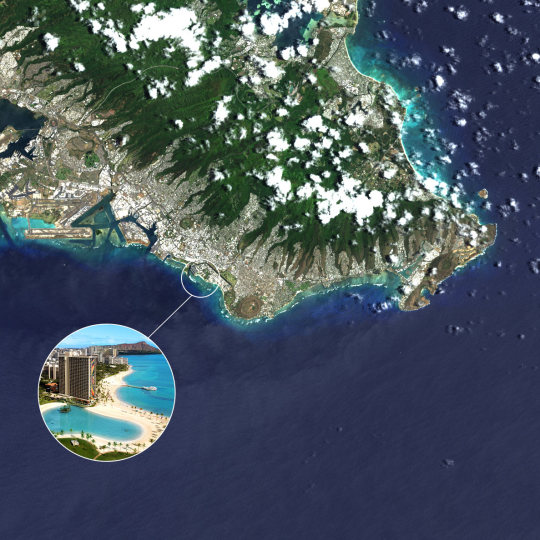
Duke Kahanamoku Beach is named for the famous native Hawaiian who was a big-board surfer and introduced surfing as a sport to mainland Americans and indeed the world.
One of the prominent features on this Landsat image is Diamondhead with its circular shape near the coast. This large cone of an extinct volcano provides the iconic backdrop for photos of Waikiki Beach.
“This is my favorite spot at the world-famous Waikiki Beach where you can both play in the surf and swim in the calm lagoonal waters.” – Dr. Beach
Landsat 8 collected this image of Duke Kahanamoku Beach on May 17, 2020.
5. Lighthouse Beach, Buxton, Outer Banks of North Carolina
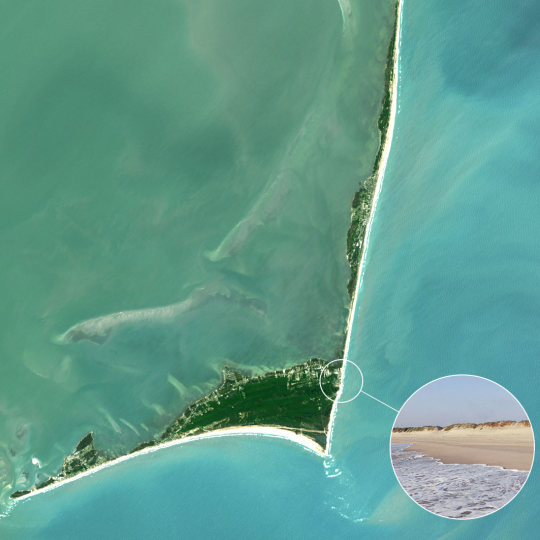
Lighthouse Beach in the village of Buxton is located at Cape Hatteras, the most northern cape in the Outer Banks of North Carolina. This lifeguarded beach is the number one surfing spot on the US Atlantic Coast as the large offshore sand banks, known as Diamond Shoals, cause wave refraction focusing wave energy on this beach.
The Landsat image shows the seaward growth of south flank of Cape Hatteras as evidenced by the parallel lines of beach ridges.
“It is fun to walk down the narrow sand spit, more exposed at low tide, as waves are approaching from both directions because of the bending of the waves.” – Dr. Beach
Landsat 8 collected this image of Lighthouse Beach on May 3, 2020.
4. St. George Island State Park, Florida Panhandle
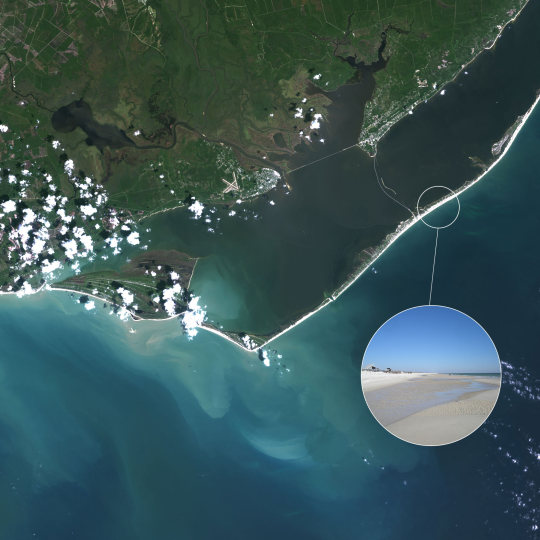
St. George Island State Park, located on the Florida panhandle and far from urban areas, is a favorite destination for beachgoers, anglers and bird watchers as nature abounds. Like other beaches on the panhandle, this long barrier island has a sugary fine, white sand beach.
In this Landsat image, St. George can be seen north of the bridge that links this barrier island to the mainland. The enclosed bay behind St. George Island is fairly shallow and the water much less clear as shown on the Landsat image, but it is not polluted.
“Besides swimming in the crystal-clear Gulf of Mexico waters, I enjoy beachcombing and shelling. While this island was hit hard in 2018 by Hurricane Michael, it has substantially recovered as there was little development to be impacted.” – Dr. Beach
Landsat 8 collected this image of St. George Island State Park on October 13, 2020.
3. Ocracoke Lifeguard Beach, Outer Banks of North Carolina
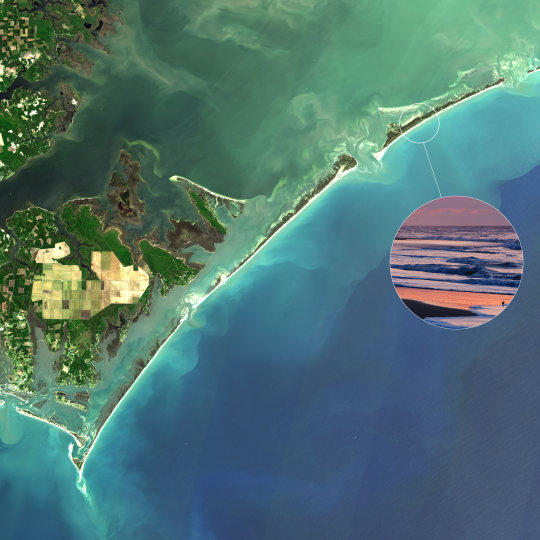
Ocracoke Lifeguarded Beach at the southern end of Cape Hatteras National Seashore was the first seashore to be incorporated into the National Park Service system.
The Landsat image shows Ocracoke to the north as separated by an inlet from Portsmouth Island. The village of Ocracoke was built at the wide area of the island where it was protected from oceanic waves during coastal storms which include both winter nor’easters and hurricanes.
“Ocracoke was once the home of the most infamous pirate Blackbeard and is still a very special place—my favorite getaway beach.” – Dr. Beach
Landsat 8 collected this image of Ocracoke Lifeguard Beach on May 3, 2020.
2. Cooper’s Beach, Southampton, New York
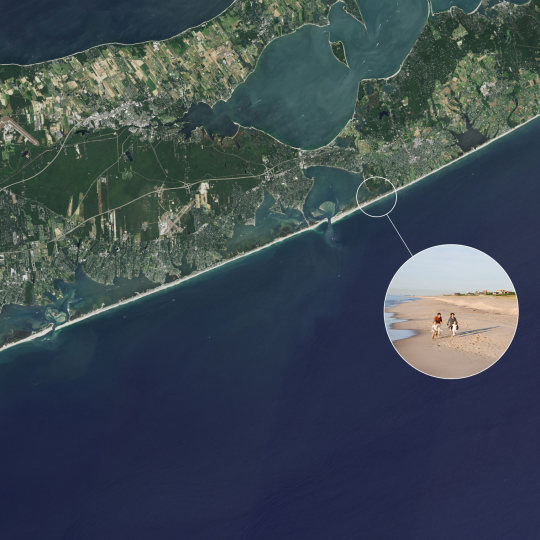
Cooper’s Beach in the tony town of Southampton on the south shore of Long Island, New York is shielded from the cold Labrador current, making for a fairly long summer swimming season. The white quartz sand is medium to coarse grained with some pebbles, making the beach slope fairly steeply into the water.
This Landsat image shows the fairly large coastal pond named Mecox Bay to the east with Shinnecock Inlet and Bay also displayed to the west. Coopers Beach is hundreds of yards wide, made of grainy white quartz sand and is backed by large sand dunes covered by American beach grass.
“I spent several decades conducting scientific studies of this very interest oceanic shoreline because it is so dynamic and the beachfront real estate so expensive. Some of the most gorgeous and expensive residential houses in the United States are located in the world-famous Hamptons.” – Dr. Beach
Landsat 8 collected this image of Coopers Beach on August 30, 2019.
1. Hapuna Beach State Park, Big Island Hawaii
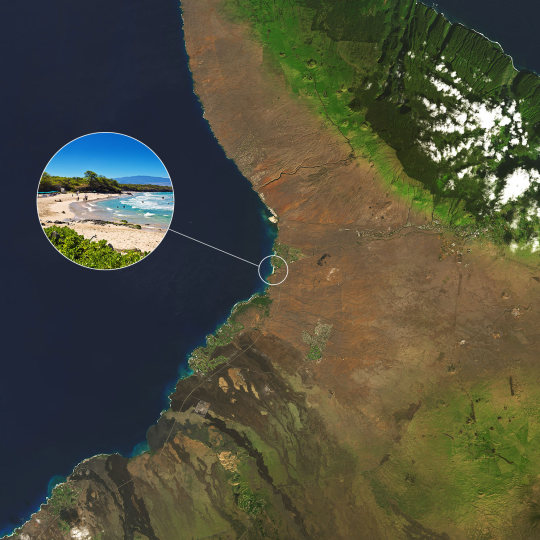
Hapuna Beach State Park is a white coral sand beach that resides in a landscape dominated by dark brown lava flows on the Big Island of Hawaii. The crystal-clear water is perfect for swimming, snorkeling, and scuba diving during the summer months in contrast to winter big-wave days when pounding shorebreaks and rip currents make swimming impossible.
Hapuna and the other pocket beaches appear as an oasis in this otherwise fairly bleak landscape except for the areas irrigated as prominently shown on the Landsat imagery by the green vegetation.
“This volcanically active island is the only place that I know where you can snow ski at the high mountain tops and water ski in the warm ocean water on the same day.” – Dr. Beach
Landsat 8 collected this image of Hapuna State Park on January 5, 2021.
What’s your favorite beach?
View Dr. Beach’s 2021 picks and see Landsat views of these beaches over time.
Make sure to follow us on Tumblr for your regular dose of space!
1K notes
·
View notes
Photo









Happy Birthday, Hubble!
The Hubble Space Telescope (HST) is a space telescope that was launched into low Earth orbit in 1990 and remains in operation. Although not the first space telescope, Hubble is one of the largest and most versatile, and is well known as both a vital research tool and a public relations boon for astronomy. The HST is named after the astronomer Edwin Hubble, and is one of NASA’s Great Observatories, along with the Compton Gamma Ray Observatory, the Chandra X-ray Observatory, and the Spitzer Space Telescope.
With a 2.4-meter (7.9 ft) mirror, Hubble’s four main instruments observe in the near ultraviolet, visible, and near infraredspectra. Hubble’s orbit outside the distortion of Earth’s atmosphere allows it to take extremely high-resolution images, with substantially lower background light than ground-based telescopes. Hubble has recorded some of the most detailed visible light images ever, allowing a deep view into space and time. Many Hubble observations have led to breakthroughs in astrophysics, such as accurately determining the rate of expansion of the universe.
sourcet: Wikipedia & Overview
Image credit: NASA/ESA & Hubble
7K notes
·
View notes
Text
Watch "An Easter Story by MJ Keenan" on YouTube
youtube
0 notes
Video
A continuous zoom from the Milky Way into the Pillars of Creation using images from Hubble
983 notes
·
View notes
Photo
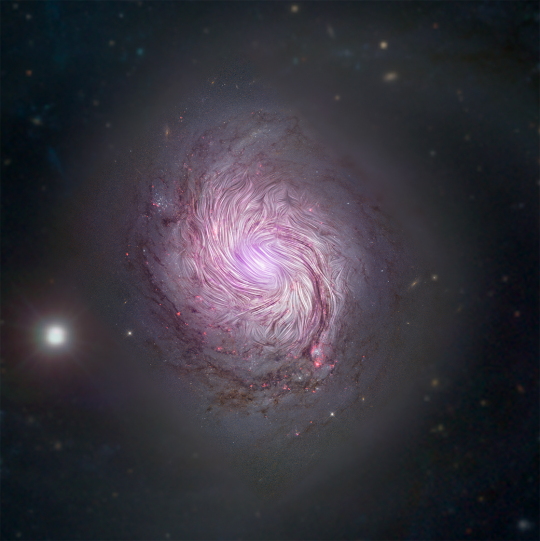
Shaping a Spiral Galaxy
Magnetic fields in NGC 1068, or M77, are shown as streamlines over a visible light and X-ray composite image of the galaxy from the Hubble Space Telescope, NuSTAR or the Nuclear Spectroscopic Array, and the Sloan Digital Sky Survey.
The magnetic fields align along the entire length of the massive spiral arms — 24,000 light years across (0.8 kiloparsecs) — implying that the gravitational forces that created the galaxy’s shape are also compressing the its magnetic field.
This supports the leading theory of how the spiral arms are forced into their iconic shape known as “density wave theory.” SOFIA, the Stratospheric Observatory for Infrared Astronomy, studied the galaxy using far-infrared light (89 microns) to reveal facets of its magnetic fields that previous observations using visible and radio telescopes could not detect.
Learn more: How to Shape a Spiral Galaxy
Image Credit: NASA/SOFIA; NASA/JPL-Caltech/Roma Tre Univ.
Source: NASA
87 notes
·
View notes
Photo

Or does it ?
There’s nothing quite like a paradox to get the physics geek in all of us going, or a moment of mind ending thought before returning to the mundane.
Einstein saw black holes in what we would think of as the classic relativity sense, a gravity so intense that it warps space/time meaning whatever goes in, stays in, incapable of ever being able to return.
Hawkins and co in the 70s introduce a new side line, quantum theory, and according to that, just at the event horizon radiation does escape, the radiation that would ultimately see the black hole shrink and die after consuming all available mass. That radiation though is random, seems to bare no connection whatsoever to the object that first entered. If I took a block of lead having the same mass as you, and then threw you both into the black hole, the black hole would increase it’s mass by twice your weight, but the radiation released would not be any clearer between the lead or you.
This Hawkins saw as a paradox, that information was going into the black hole, but was not returning out.
A new paper looks at how it’s possible that the radiation could in fact be linked to the matter that fell in, and describes a process internal to the singularity which if you’re anything like me, will get you reading it several time with “you say what ?” But put in layman’s terms, quantum entanglement remains and the radiation is just so scrambled, it looks like a block of data that has entered a encryption algorithm and been scrambled out, and if only we had access to the key, we could prove that eventually all matter that enters the black hole does in fact come back out, albeit shredded down to just radiation.
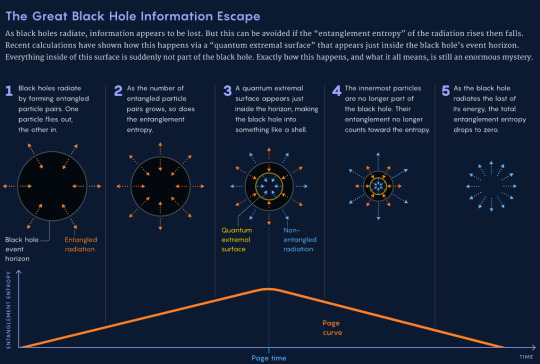
It’s a long read but if you want to wonder at both the complexity of what we know and the giant gulf of what we don’t, it’s a super read.
Source :
https://www.quantamagazine.org/the-black-hole-information-paradox-comes-to-an-end-20201029/
67 notes
·
View notes
Video
youtube
Video by TED-Ed: The greatest mathematician that never lived:
Dig into the mystery of Nicolas Bourbaki— one of the most influential mathematicians of all time… who never actually existed.
92 notes
·
View notes
Video
youtube
Video by CrashCourse: Cyclohexanes: Crash Course Organic Chemistry #7:
Hexagons appear all over the natural world from honeycomb to bubbles, and they even appear in organic chemistry! In this episode of Crash Course Organic Chemistry, we’re learning all about cyclohexanes, including how rings pucker to relieve strain, the boat and chair conformations, and how ring flips can switch substituents from axial to equatorial. We’ll practice a lot of chair flips, but don’t flip an actual chair just yet! Lots of practice is key to understanding organic chemistry’s favorite manifestation of the hexagon.
97 notes
·
View notes
Photo

Dude these are pretty! And they sound incredible. Gonna stream for about 90 minutes now. Hope to see you there! www.twitch.tv/LumerOfficial #drummergirl #instadrum #instadaily #musician #ihittoohard #ihitthingswithsticks #drummerproblems #drumlife #tempusdrums (at Washington D.C.) https://www.instagram.com/p/CEfKQh4BU3x/?igshid=1p5zwdwufalun
#drummergirl#instadrum#instadaily#musician#ihittoohard#ihitthingswithsticks#drummerproblems#drumlife#tempusdrums
0 notes
Photo

I think I see the problem. #sjcdrums #mikelumer #fatdrummer #drummergirl #instadrum #instadaily #musician #ihittoohard #ihitthingswithsticks #drummerproblems (at Washington D.C.) https://www.instagram.com/p/CEe5gmehLmk/?igshid=48izjvsqdjrb
#sjcdrums#mikelumer#fatdrummer#drummergirl#instadrum#instadaily#musician#ihittoohard#ihitthingswithsticks#drummerproblems
0 notes
Photo

I went to Northern Iraq (no, really) and talked to two former ISIS slaves and one of those Liam Neeson-esque rescuers for Part 2 of our series, “Holy Shit, Cracked Sent Someone To Previously Occupied ISIS Territory. Dude, That’s Fucked Up. Why Would They Do That."
Our first source, M, was 17 when ISIS captured her. Her sin was that she’s not a Muslim – she’s a Yazidi, part of a religious minority in the region. She escaped her home in August of 2014, when ISIS was blitzkrieging its way across the Yazidi heartland near Mt. Sinjar in Iraq. M took refuge in an old fort on the mountain, but was quickly captured and taken to the nearby town of Tel Afar. Several thousand of her people would meet a similar fate.
ISIS tends to use old school buses to transport their human stock, and then stash them inabandoned public buildings. M’s first stop was a former school. "There were a lot of people – full of people. Kids, women, and girls. But no men.” After a few days, she was moved to Badosh prison in the ISIS-occupied city of Mosul. Her transit was interrupted several times by air strikes, which is probably the only situation in which being interrupted by air strikes could be a good thing.
We Were Slaves of ISIS: 7 Things You Should Know
290 notes
·
View notes
Photo
Totally read the name as "my little anal fart"

Yes, this is real. They looked like a cross between a unicorn and a wooly mammoth!

Guys - if evolution had taken a different route, we could have had Equestria on earth … real unicorns ruling the world!
587 notes
·
View notes
Photo


Young star lights up reflection nebula IC 2631
A newly formed star lights up the surrounding cosmic clouds in this image from ESO’s La Silla Observatory in Chile. Dust particles in the vast clouds that surround the star HD 97300 diffuse its light, like a car headlight in enveloping fog, and create the reflection nebula IC 2631. Although HD 97300 is in the spotlight for now, the very dust that makes it so hard to miss heralds the birth of additional, potentially scene-stealing, future stars.
The second image shows the sky around IC 2631 in the constellation of Chameleon.
Credit: ESO
608 notes
·
View notes
Photo
Amazing

New Implant Turns Immune System Against Alzheimer’s
In a cutting-edge treatment for Alzheimer’s disease, EPFL scientists have developed an implantable capsule that can turn the patient’s immune system against the disease
The research is in Brain. (full access paywall)
196 notes
·
View notes
Photo

A gif showing human evolution. This is my favorite one.
51K notes
·
View notes